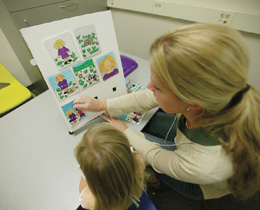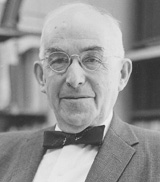Volume 25 · Number 2 · Winter 2008
News & Notes

Psychologist Kristin Lagattuta, during an interview with a 3-year-old, uses picture cards showing a variety of emotions. Lagattuta asked the child to pick cards that matched her response to a story in which the central character is wronged and days later comes across a person or animal who looks similar to the wrongdoer. (Photo: Paul Estabrook)
In memoriam
Women and worry
New research by UC Davis psychologist Kristin Lagattuta suggests a possible reason why anxiety rates are higher in women than in men: Women are more likely to anticipate potential threats based on past experiences.
In two studies reported in the September/October issue of the journal Child Development, Lagattuta found that from the age of 4, females are more likely than males to anticipate future “what ifs.”
In her first study, Lagattuta presented six simple stories to 64 study participants ranging in age from 4 to 23. In each story, a character is wronged and then, when encountering the same wrongdoer days later, either experiences worry or takes protective steps.
In “David’s Story,” for example, a red-haired boy steals David’s favorite teddy bear. Many days later, David sees the red-haired boy again and feels worried. In an alternative version of the story, David sees the red-haired boy again and decides to hide his toy cars.
After hearing a story, children and adults were asked to explain the cause of the worry or the behavior change.
In the second study, Lagattuta told stories to a different set of 64 study subjects, this time ages 3 to 23. In these stories, the central character is wronged and days later encounters a person or animal that looks similar, but not identical, to the wrongdoer.
David, for example, again has his teddy bear stolen by a red-haired boy and later sees a different red-haired boy.
Research participants were asked to predict and explain the central character’s emotion or were asked to explain why the character felt worried.
Across ages, females in the first study were more likely than males to explain worry or protective behaviors as caused by events that “might” or “could” happen in the future versus events that were certain to happen. Females in the second study more often predicted the character would feel worried or take protective steps, even though a different animal or person was encountered.
“This across-age gender difference in predicting and explaining worry and preventative actions is intriguing in light of research showing that female children and adults have more frequent and intense worries,” Lagattuta said. “Indeed, this research suggests that gender differences in reasoning about potential risk situations may begin during the preschool years.”
— Claudia Morain
Namesakes: Storer Hall

Tracy Storer, 1889-1973
Few people knew the wildlife of the Sierra Nevada the way Tracy Storer did. Not only did he write the book on Sierra fauna — in fact, more than one — he did much of the original research, starting in 1914 with an unprecedented survey of the animals of Yosemite.
Storer, as a graduate student and curator of birds at the Museum of Vertebrate Biology at UC Berkeley, worked with the museum’s founding director, Joseph Grinnell, and others in a six-year inventory of the “Yosemite Transect” — a swath of land stretching more than 1,500 square miles from the Central Valley through Yosemite Valley to Mono Lake.
Just getting to Yosemite in those days was a feat. In a memoir, Storer would recall a 1919 trip when he and Grinnell had to unpack their Model T, hand carry their gear and reload the car at every hairpin turn in the road. The fieldwork involved camping with packhorses and walking 20 miles or more a day.
In the end, they collected 4,354 specimens, took more than 700 photos and filled more than 2,000 pages with notes. A resulting 1924 book, Animal Life in the Yosemite, written by Grinnell and Storer, describes 362 kinds of animals — 231 types of birds, 97 mammal species, 22 snakes and lizards, and 12 frogs, toads and salamanders. Moreover, the book broke new ground in discussing the distribution of those species across different “life zones,” or ecological niches.
“This study was truly a landmark,” said James Patton, a UC Berkeley biology professor emeritus and a curator at the Museum of Vertebrate Biology who recently worked with colleagues on the first resurvey of the Yosemite Transect. “Ecology wasn’t even a field at that time, and the kind of ‘Victorian-age’ gentleman’s field of natural history was just beginning to be transcribed into a truly scientific discipline. Folks like Grinnell and Storer were some of the early architects of that transformation.”
The pair also became early advocates for preserving Yosemite’s native wildlife — including predators — and natural habitats.
Storer left a big imprint at UC Davis, as well. In 1923, he joined the campus as the first and, for many years, the only zoology faculty member — the start of what would eventually become one of the nation’s leading university biological sciences teaching and research programs.
He and his wife, Ruth, the first woman doctor in Yolo County, in 1960 endowed a speaker series that brings eminent biologists to campus every year.
Students worldwide knew Storer well for his classic General Zoology textbook. His legacy also includes two other long-lived books: Sierra Nevada Natural History, a guidebook recently updated and released by University of California Press, and California Grizzly, which he co-authored with UC Davis colleague Lloyd Tevis in 1955 and was reissued in 1996.
Storer also had a hand in fixing the California state flag. Before 1953, the bear on the flag often drew comparisons to a hog or a dog. Because the California grizzly had been extinct since 1922, few knew what it looked like. Storer helped the state come up with a more accurate rendition.
— Kathleen Holder

(Photo: David Phillips ’88)
Night game
While most people were home sleeping, David Phillips ’88 set up his camera outside the Aggies’ new stadium to capture the Aug. 28 lunar eclipse over the entry gate. Phillips, who works during the day as associate director of UC Davis
Facilities: Operations and Maintenance, took photos from about 2 to 6 a.m. as the moon passed through the earth’s
shadow. He created this composite image from seven separate shots.
The Quad takes root
As the campus nears its 2008–09 centennial celebration, we take a look back at what was happening 100 years ago.
In winter 1907–08, the University Farm consisted of a few buildings and some experimental crops. But plans were in the works for a feature that would become central to campus life over the next century — the tree-lined Quad.
“University Farm to Have Shaded Avenues” read a December 1907 headline in the Davis Enterprise. Over the next few months, UC Professor Warren Clarke oversaw the planting of trees along what is now Shields Avenue on the Quad’s southern edge.

The Quad didn’t acquire its name and square shape until later, but the campus’s first general plan in 1908 called for shingled wood buildings — including dormitories, a dining hall and teaching facilities — to be constructed around an open court.
By fall 1907, two instructional buildings had already been constructed on that court’s south end — a creamery, which no longer exists, and a livestock pavilion that would double as an auditorium and would later be moved and converted to Wyatt Theatre.
Architects that winter drew plans for the first dormitories and a dining hall to be built facing the Quad. The dorms, North Hall, built in summer 1908, and South Hall, finished in 1912, now house student services. The former dining hall, East Hall, was constructed in 1909; it would later be moved and become the first home of the Coffee House before it was torn down in 1974.
The Quad itself would eventually be expanded to double the size of the original plan, serving over the years as teaching fields and then gathering place — a site for student demonstrations, art exhibits, Whole Earth Festivals, lunches, Frisbee and ball games, study sessions and naps.
Some American elms planted by horticulturist Clarke still shade Shields Avenue a century later, but they are in declining health, said Skip Mezger, a senior landscape architect with the campus grounds division. With many trees nearing the end of their lives, the campus is taking steps to ensure a healthy shade canopy and a vibrant Quad for the next century.
Grounds officials in 2005 launched a 100-year tree plan to plant new trees. With the help of a $175,000 grant from the Getty Foundation, UC Davis is also developing a landscape heritage plan that, among other things, will address how to keep the Quad landscaping healthy.
And to mark its 1908–09 centennial, UC Davis plans to unveil a Centennial Walk, an upgraded path through the center of the Quad.
— Kathleen Holder
